این مقاله به فارسی نیز وجود دارد. در اینجا آن را مطالعه نمایید.
-Written by Mohammad Reza Kamali
-Edited by Allacin Morimizu
As we said in parts 1-3 (see links at the end of this article), the assumption that Tolkien wrote all his stories based on inspirations from his favorite regions and cultures is not well founded. As a creative and knowledgeable scholar, Tolkien was completely free to write his stories as he saw fit.
To find out whether Europe or anywhere else was really the source of inspiration for Tolkien’s work, we need to have documented evidence. The most famous evidence from Tolkien’s writings about comparing our earth to Middle-earth is his famous Letter 294:
The action of the story takes place in the North-west of ‘Middle-earth’, equivalent in latitude to coastlands of Europe and the north shores of the Mediterranean… If Hobbiton and Rivendell are taken (as intended) to be about the latitude of Oxford, then Minas Tirith, 600 miles south, is at about the latitude of Florence. The Mouths of Anduin and the ancient city of Pelargir are at about the latitude of ancient Troy.
But as we saw in detail in part 1 of this article series, Tolkien’s note on the annotated map that was discovered fairly recently helps us understand he is not saying in Letter 294 that he was inspired by Europe itself in creating his Middle-earth map, but that he was using well-known European locations to illustrate the position and dimensions of Middle-earth.
We have talked many times about Letter 294 in my article series because has long been considered the greatest enemy of my research, which considers Tolkienian influences further east than Europe. Because of this letter, for years my research has been quickly dismissed almost as a joke, and few took it seriously. But when the annotated map notes were found, the situation suddenly changed. Let’s look at the situation afresh.
What exactly is Letter 294?
It comes from the numbering of letters in The Letters of J. R. R. Tolkien, written by the great Tolkien researcher Humphrey Carpenter. The letter is addressed to Charlotte and Dennis Plimmer, who interviewed Tolkien for the Daily Telegraph Magazine. Their article was later published as “The Man Who Understands Hobbits.” At that time, the Plimmers sent a draft of the article to Tolkien to find out what he thought about it and to correct any flaws. In response, Tolkien sent them a letter with the amendments he intended. This is the famous letter 294!
Dear Mr and Mrs Plimmer,
Thank you for your courtesy in sending me a copy of the preliminary draft of your article. It is evident that I presented some difficulties to you during the interview: by my swift speech (which is congenital and incurable), my discourtesy in walking about, and my use of pipe. No discourtesy was intended. I suffer from arthritis and my knees give me pain if I sit for long. It is one alleviation of being interviewed if I can stand. I should forgo smoking on these occasions, but I have found being interviewed increasingly distasteful and distracting, and need some sedative.
The copy came to this address the day before I returned hoping to get on with my proper work; I have now found time to consider it. There are one or two points which I should prefer to see altered, and some inaccuracies and some misunderstandings that have, no doubt partly by my own fault, crept into the text. Among my characteristics that you have not mentioned is that in fact I am a pedant devoted to accuracy, even in what may appear to others unimportant matters. I have not had time to state these points clearly and legibly, and I hope that the revision and cutting of your article can still wait a day or two. I will try to send them off to reach you by Friday.
In one point I fear that I shall disappoint you. I am informed that the Weekend Telegraph wishes to have your article illustrated by a series of pictures taken of me at work and at home. In no circumstances will I agree to being photographed again for such a purpose. I regard all such intrusions into my privacy as an impertinence, and I can no longer afford the time for it. The irritation it causes me spreads its influence over a far greater time than the actual intrusion occupies. My work needs concentration and peace of mind.
Yours sincerely
J. R. R. Tolkien
Tolkien then lists 13 parts of the article that he thinks should be amended, and writes below each section his objections to that part. There are some interesting points in these objections, from the description of Tolkien’s height to his relationship with C .S. Lewis. In the seventh objection, he objects to this sentence:
Middle-earth … corresponds spiritually to Nordic Europe.
The following words in (parentheses) are from Tolkien himself, and the words in [brackets] specify what he is obviously referring to:
Not Nordic, please! A word I personally dislike; it is associated, though of French origin, with racialist theories. Geographically Northern is usually better. But examination will show that even this [Northern Europe] is inapplicable (geographically or spiritually) to ‘Middle-earth’. This [Middle-earth] is an old word, not invented by me, as a reference to a dictionary such as the Shorter Oxford will show. It meant the habitable lands of our world, set amid the surrounding Ocean. The action of the story takes place in the North-west of ‘Middle-earth’, equivalent in latitude to coastlands of Europe and the north shores of the Mediterranean. But this is not a purely ‘Nordic’ area in any sense. If Hobbiton and Rivendell are taken (as intended) to be about the latitude of Oxford, then Minas Tirith, 600 miles south, is at about the latitude of Florence. The Mouths of Anduin and the ancient city of Pelargir are at about the latitude of ancient Troy.
Auden has asserted that for me ‘the North is a sacred direction’. That is not true. The North-west of Europe, where I (and most of my ancestors) have lived, has my affection, as a man’s home should. I love its atmosphere, and know more of its histories and languages than I do of other parts; but it is not ‘sacred’, nor does it exhaust my affections. I have, for instance, a particular love for the Latin language and among its descendants for Spanish. That it is untrue for my story, a mere reading of the synopses should show. [In my stories] the North was the seat of the fortresses of the Devil. The progress of the tale ends in what is far more like the re-establishment of an effective Holy Roman Empire with its seat in Rome than anything that would be devised by a ‘Nordic’.
Honestly, the general meaning of the text we have just read is not what we have ever heard about Tolkien’s Letter 294 at all. Until now, Letter 294 had been said to clearly indicate that Europe is Middle-earth in Tolkien’s opinion. But when we pay careful attention to what Tolkien says about how his upbringing influences his interests, it seems he is saying something like this:
I may be interested in Northern Europe, Northwestern Europe, Latin and Spanish languages, but I have not based my stories on them because I do not write my stories based on my interests!
The meaning of the text seems to have changed completely, but why? Problems always arise when sentences are not considered in their context. Now that you have read the full text, why do you think the two sentences about Europe and Middle-earth are usually separated from the rest of the text?
Both at the beginning and at the end of Letter 294, Tolkien explicitly denies being influenced by Northern Europe, Northwestern Europe, and even in general by his favorite subjects, citing Spanish as an example. But unexpectedly, in the middle of this explanation, he suddenly talks about how Middle-earth relates to Europe.
As previously mentioned, those two sentences do not really refer to the issue of what inspired him. But even when realizing that Tolkien said “equal in latitude,” not “equal,” the question still arises why Tolkien, in the middle of his explanation to the Plimmers, suddenly decides to talk about map latitudes.
Let’s go back to the opening part of the letter:
Among my characteristics that you have not mentioned is that in fact I am a pedant devoted to accuracy, even in what may appear to others unimportant matters.
Tolkien was a very precise man. As a pedant myself, I can testify that Professor Tolkien is one of the most pedantic authors I have ever encountered in the literary world, which is one reason I like him so much. In addition to his alphabets and languages, he created chronologies, family trees, and even numerous calendars for the various races of his creatures. The Shire calendar is one of the most beautiful and regular calendars I have ever seen. I do not think that the order and accuracy in his works are merely the imaginings of a fantasy writer, but are also the efforts of a superb researcher. It is true that Tolkien was a fantasy writer, but he himself did not live in a fantasy world. He relied not only on his powerful imagination and ingenuity to create his fairy stories, but also on his diligence, patience, and thorough research. He struggled for years with every detail in those stories to make them believable.
Going forward, you will see things about Tolkien’s accuracy that fully justify this praise. For now, we can believe he is confident in what he is saying.
We turn now to the main part of the letter for our purposes, Tolkien’s opposition to Middle-earth’s being equated spiritually with Northern Europe. Let us carefully examine each segment of Tolkien’s objections:
Not Nordic, please! A word I personally dislike; it is associated, though of French origin, with racialist theories.
Tolkien explains why he does not like the word Nordic, and then adds that, contrary to the Plimmers’ article, Middle-earth has nothing to do with northern Europe:
Geographically Northern is usually better. But examination will show that even this [Northern Europe] is inapplicable (geographically or spiritually) to ‘Middle-earth’.
This is an issue he emphasizes three more times:
But this is not a purely ‘Nordic’ area in any sense.
Auden has asserted that for me ‘the North is a sacred direction’. That is not true.
The North was the seat of the fortresses of the Devil. The progress of the tale ends in what is far more like the re-establishment of an effective Holy Roman Empire with its seat in Rome than anything that would be devised by a ‘Nordic’.
After emphasizing what the Plimmers misunderstood, Tolkien begins to explain the origin and true meaning of the word Middle-earth:
This is an old word, not invented by me, as a reference to a dictionary such as the Shorter Oxford will show. It meant the habitable lands of our world, set amid the surrounding Ocean.
What is the exact meaning of that statement?
Fortunately, Tolkien gave us a detailed etymology of the word Middle-earth in Letter 211. He says it comes from the Old English word middan-geard, which changed to midden-erd and later to middle-erd in the medieval period. Tolkien modernized the spelling to Middle-earth.
Tolkien explains in Letter 294 that Middle-earth means “the habitable lands of our world, set amid the surrounding Ocean.” In Letter 165, he describes Middle-earth this way:
The name for the inhabited lands of Men ‘between the seas’.
Here’s an illustration of what the professor is talking about:
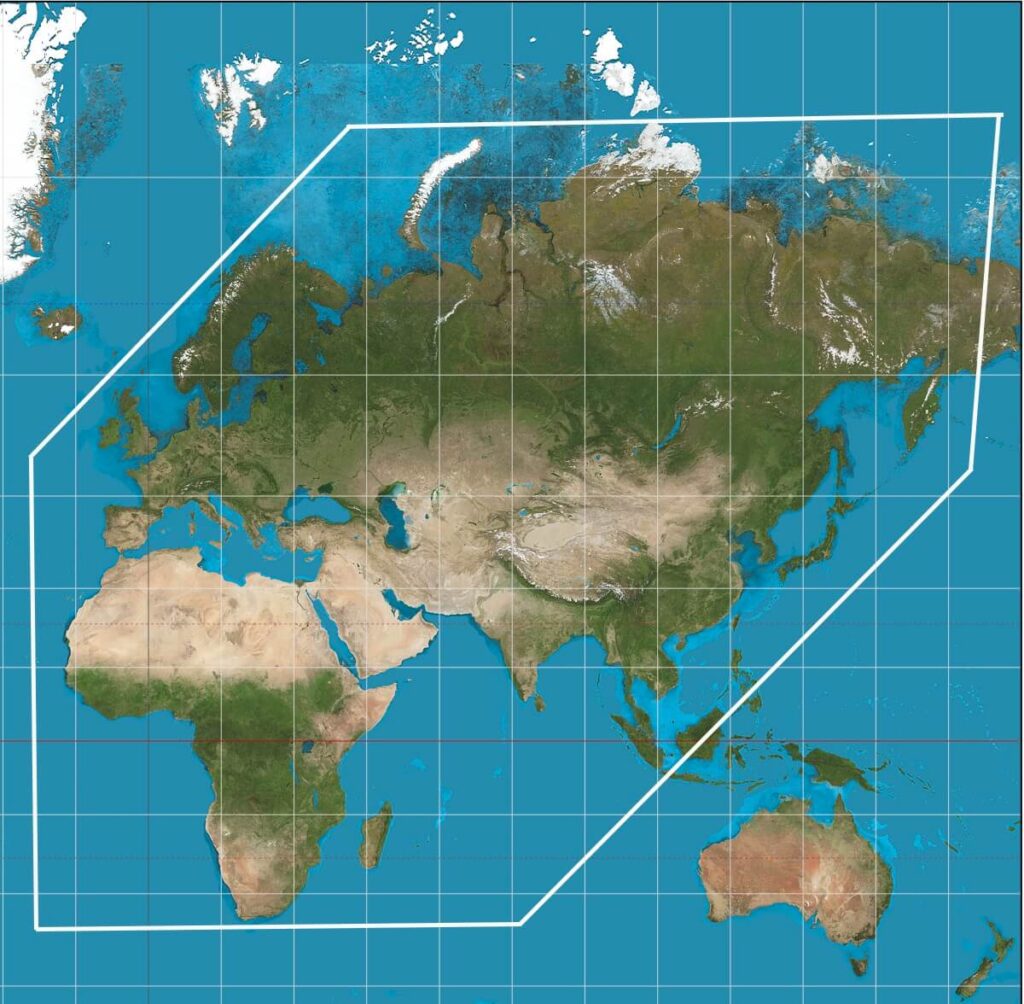
Mercator Projection, Wikipedia
This is the vast and inhabited land of our planet between the Atlantic and Pacific Oceans, which includes the continents of Europe, Asia, and Africa. So far, Tolkien has denied a direct connection between Northern Europe and Middle-earth, and explained that Middle-earth is an old name that has nothing to do with him personally. This is Tolkien’s argument:
You have assumed that Middle-earth is my invention, and since I am interested in and a product of Northern culture, you have probably concluded that Middle-earth spiritually corresponds with Northern Europe, but that is not true. Middle-earth existed as a word and concept long before my time.
Tolkien then proceeds to explain Europe’s relationship with Middle-earth:
The action of the story takes place in the North-west of ‘Middle-earth’, equivalent in latitude to coastlands of Europe and the north shores of the Mediterranean. But this is not a purely ‘Nordic’ area in any sense.
As we saw in the map above, Middle-earth on our earth refers to the three continents in the white boundaries between the Atlantic and Pacific Oceans. But where is Middle-earth in Tolkien’s stories?
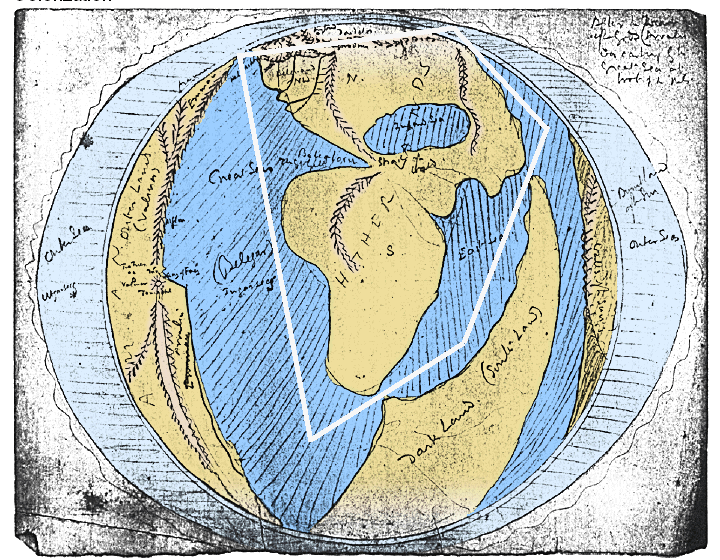
© The Tolkien Estate Limited – used with kind permission.
This is the map of Arda in the second age as drawn by J. R. R Tolkien. The area inside the white box shows Middle-earth. But what is this depicting?
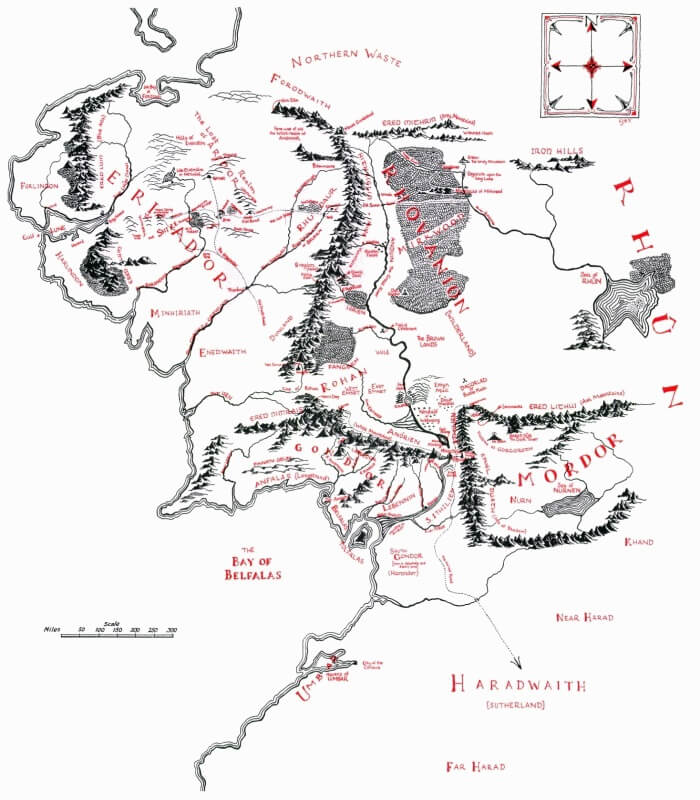
© The Tolkien Estate Limited – used with kind permission.
This map shows only the northwestern part of Middle-earth, which is most familiar to us because most of The Lord of the Rings and The Hobbit stories take place in this section. As shown in Arda map, Middle-earth in Tolkien’s world, like its Old English inspiration, is a large land surrounded by seas. This is what Tolkien said about that in Letter 211:
I have, I suppose, constructed an imaginary time, but kept my feet on my own mother-earth for place. I prefer that to contemporary mode of seeking remote globes in ‘space’.
He said something similar in Letter 183:
The theatre of my tale is this earth, the one in which we now live, but the historical period is imaginary.
But when you equate our middle earth with Tolkien’s Middle-earth, you may logically conclude that the most important part of Middle-earth, its northwest, is probably equivalent to the western coast of Europe. Tolkien raises this issue in our main letter, 294:
The action of the story takes place in the North-west of ‘Middle-earth’, equivalent in latitude to coastlands of Europe and the north shores of the Mediterranean.
But what does that have to do with the misinterpretation of the Plimmers that he was trying to correct in the main part of this famous letter? Its relevance is specified in the following sentence:
But this is not a purely ‘Nordic’ area in any sense.
That sentence is always removed from quotations of Letter 294 and replaced by three dots because so many writers think it has nothing to do with the previous and following sentences, but they are making a mistake! To fully understand the meaning of Tolkien sentences, we must take them in the order he intentionally gave them:
It meant the habitable lands of our world, set amid the surrounding Ocean. The action of the story takes place in the North-west of ‘Middle-earth’, equivalent in latitude to coastlands of Europe and the north shores of the Mediterranean. But this is not a purely ‘Nordic’ area in any sense.
With the help of Tolkien’s previous explanations of the meaning and roots of Middle-earth, we can understand him to be saying essentially this:
My Middle-earth is equivalent to the Old English middle earth, meaning the three continents of Africa, Asia, and Europe. The northwest of my Middle-earth is geographically equivalent to northwestern Europe, but that is a mix of diverse countries, ethnicities, cultures, languages, and myths far beyond Nordic Europe. Then Tolkien, who gives a reason for each claim, also proves to the Plimmers that his Middle-earth does not include Nordic Europe:
If Hobbiton and Rivendell are taken (as intended) to be about the latitude of Oxford, then Minas Tirith, 600 miles south, is at about the latitude of Florence. The Mouths of Anduin and the ancient city of Pelargir are at about the latitude of ancient Troy.
Those sentences do not at all show that those European cities inspired Tolkien to write Middle-earth equivalents in his Legendarium. Instead, they are a continuation of Tolkien’s previous statement that the dimensions and boundaries of northwest Middle-earth roughly correspond to those of northwestern Europe in terms of latitude.
As we saw in part 1 of this article series, citing Tolkien’s notes to his map illustrator, Pauline Baynes, Tolkien changes the destination city from Florence to Ravenna and then to Belgrade to determine the dimensions of the map more precisely for Baynes.
Tolkien went on to write in Letter 294:
Auden has asserted that for me ‘the North is a sacred direction’. That is not true.
What is the story behind this sentence? In 1966 The New Yorker magazine published a report on the American Tolkien Society meeting. The famous English poet W. H. Auden was the guest speaker. He said in his speech:
Tolkien is fascinated with the whole northern thing. People seem to divide—they’re attracted by either the Northern thing or the Southern thing, by Scandinavia or the Mediterranean—and for Tolkien north is a sacred direction.[i]
Why did Tolkien refer to Auden’s speech in his letter to the Plimmers? He may have guessed that the Plimmers made their erroneous assumption based on what that influential poet wrongly stated. Tolkien then gave a strong reason to show that the North was not sacred for him:
The North-west of Europe, where I (and most of my ancestors) have lived, has my affection, as a man’s home should. I love its atmosphere, and know more of its histories and languages than I do of other parts; but it is not ‘sacred’, nor does it exhaust my affections.
He is saying that although he naturally and appropriately appreciates the land of his ancestry, his affections and interests range far beyond it. Tolkien is humble enough not to assume that whatever he happened to grow up with is automatically best or sacred. Tolkien is declaring his independence from his favorite subjects, saying do not confuse “my stories” with “my favorite subjects.” I do not have to write stories based merely on my favorite subjects; like any human being, I can love other things too!
He goes on to give a different example because he probably guessed that the Plimmers and others would not believe that he was not directly inspired by northwestern Europe! This is Professor Tolkien’s primary area of expertise, linguistics:
I have, for instance, a particular love for the Latin language and among its descendants for Spanish. That it is untrue for my story, a mere reading of the synopses should show.
He did not rely merely on his memories, feelings, and interests to create his stories and worlds; he was a researcher-writer who gave himself the right to research any subject, character, story, or place in the world that he considered appropriate to write or draw about.
He then reiterates that the North is not sacred to him because the North is not a good place in his stories:
The North was the seat of the fortresses of the Devil [called Melkor and Morgoth in The Silmarillion].
This last sentence in our portion of Letter 294 is probably in response to Auden’s dividing people into Nordic and Mediterranean groups. According to Tolkien, his stories are more Mediterranean than Nordic:
The progress of the tale ends in what is far more like the re-establishment of an effective Holy Roman Empire with its seat in Rome than anything that would be devised by a ‘Nordic’.
Now that we’ve examined all the parts, let’s re-examine the whole to bring this matter to a close:
Not Nordic, please! A word I personally dislike; it is associated, though of French origin, with racialist theories. Geographically Northern is usually better. But examination will show that even this [Northern Europe] is inapplicable (geographically or spiritually) to ‘Middle-earth’. [Careful examination reveals] this is an old word, not invented by me, as a reference to a dictionary such as the Shorter Oxford will show. It meant the habitable lands of our world [the continents of Africa, Asia and Europe between the Atlantic and Pacific], set amid the surrounding Ocean. The action of the story takes place in the North-west of ‘Middle-earth’, equivalent in latitude to the coastlands of Europe and the north shores of the Mediterranean. But this is not a purely ‘Nordic’ area in any sense [but a mix of different countries and cultures]. If Hobbiton and Rivendell are taken (as intended) to be about the latitude of Oxford, then Minas Tirith, 600 miles south, is at about the latitude of Florence. The Mouths of Anduin and the ancient city of Pelargir are at about the latitude of ancient Troy.
Auden has asserted that for me ‘the North is a sacred direction’. That is not true. The North-west of Europe, where I (and most of my ancestors) have lived, has my affection, as a man’s home should. I love its atmosphere, and know more of its histories and languages than I do of other parts; but it is not ‘sacred’, nor does it exhaust my affections. [Since you may not believe me, I give you an example:] I have, for instance, a particular love for the Latin language and among its descendants for Spanish. That it is untrue for my story, a mere reading of the synopses should show. [To prove that North is not sacred to me, remember that in my stories] the North was the seat of the fortresses of the Devil. [Contrary to what Auden said,] the progress of the tale [is more Mediterranean than Nordic because it ends] in what is for more like the re-establishment of an effective Holy Roman Empire with its seat in Rome than anything that would be devised by a ‘Nordic’.
Throughout this part of the letter, Tolkien is proving his point and correcting the misunderstandings that the Plimmers had about his stories. He clearly rejects Northern Europe as the inspiration for them for three strong reasons:
- Middle-earth is not my invention at all, so my natural interest in northern Europe could not have inspired me to create it!
- The western part of Middle-earth is equivalent to northwestern Europe and the northern shores of the Mediterranean, not just northern Europe.
- I do not write stories based on my personal background and interests!
In Letter 294 he focuses on the lack of connection between his stories and his favorite topics. Nowadays, however, almost every search for comparing our earth to Arda or Middle-earth leads only to the two famous sentences that at a surface view seem to equate Middle-earth with Europe. I think we need to end this fragmentary approach to Letter 294! Those sentences are part of a longer statement that Professor Tolkien carefully crafted, conveying a different meaning from what is usually assumed.
I know some people don’t like my analysis of Tolkien’s maps, letters, and writings. These are the kinds of comments I’ve received: Why are you so engrossed in his conversations and writings? What is the benefit of this? Why not just enjoy his stories? You are ruining our dreams!
The most important reason why I think it is necessary to analyze Tolkien’s statements and understand exactly what he was saying is that this was important to him. He was unusually—and brilliantly!—precise in what he wrote so we should make the effort to understand how he used every word if we are interested in knowing him and his works.
Letter 294 clearly shows the Professor was dissatisfied with people connecting things to his stories that he did not consider relevant, an error he tried to correct clearly and vigorously. In part 3 of my article series, we saw what strange interpretations of Tolkien’s stories there are. When we allow ourselves to relate Tolkien’s stories to our favorite subjects, or subjects we guess he was interested in without any proof, we are doing the very thing he disliked.
Like all fans, I love Tolkien and his stories, even more than analyzing his letters and maps. But I love truth more than anything, especially truths about Tolkien! It seems that with Tolkien and his works, as with many other beloved authors and creative efforts, the perceptions, conjectures, and aspirations of their fans inadvertently transform masterpieces into things they are not. That is a problem from which J.R.R. Tolkien himself apparently suffered greatly.
The Tale of the annotated map and Tolkien’s hidden riddles – Part One
The Tale of the annotated map and Tolkien’s hidden riddles – Part Two
The Tale of the annotated map and Tolkien’s hidden riddles – Part Three
The Tale of the annotated map and Tolkien’s hidden riddles – Part Four
 آردا، دنیای تالکین سایت طرفداران تالکین در ایران. جایی برای گفتگو در مورد ارباب حلقه ها و دیگر آثار تالکین به زبان فارسی
آردا، دنیای تالکین سایت طرفداران تالکین در ایران. جایی برای گفتگو در مورد ارباب حلقه ها و دیگر آثار تالکین به زبان فارسی
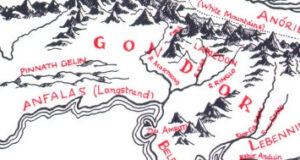

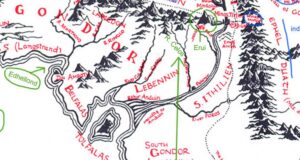
۱ دیدگاه
بازخورد: Pixel Scroll 5/23/21 Looking Up Out Of An Inkwell | File 770